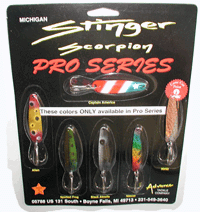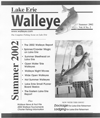|
Oh, Those Erie 'Eyes
By Bob Riege & Mark Brumbaugh
Trolling is probably the most universal methods for
catching walleyes on Lake Erie. Trolling and covering as much water as is
necessary to find active, biting fish. Far and away the most conventional
 presentation
of trolling for walleyes is by anglers forward trolling them on handheld
rods. In most conditions it would simply look like the anglers are just
towing their lures behind the boat. As with anything that appears to be so
apparently basic, there are a number of variations that enhance the
productivity of the presentation. The first of these is lure selection. In
shallow water presentations anglers will want to run small lipped floating
stickbaits (Rapalas, Rebels, Storm Lures etc).As they find the need to work
progressively deeper they will move from small sized crankbaits to larger
lures with bigger deeper diving bills. presentation
of trolling for walleyes is by anglers forward trolling them on handheld
rods. In most conditions it would simply look like the anglers are just
towing their lures behind the boat. As with anything that appears to be so
apparently basic, there are a number of variations that enhance the
productivity of the presentation. The first of these is lure selection. In
shallow water presentations anglers will want to run small lipped floating
stickbaits (Rapalas, Rebels, Storm Lures etc).As they find the need to work
progressively deeper they will move from small sized crankbaits to larger
lures with bigger deeper diving bills.
The color of the lures will often prove a key as well.
Under bright, clear water conditions the natural, lifelike lure finishes are
likely to be your top producers. On dark days, or at night, the brighter
chartreuse, Firetiger, and phosphorescent colors will be the best.
At this time of the year combining spinners and crawlers
along with Rapala Sad Raps will give the angler a variety of baits in the
water when fished in conjunction with snap weights and off-shore planer
boards. Boards give you the option of fishing multiple lines and covering
lots of water fast and with this variance in depths you cover all columns of
water for both suspended and bottom feeding fish.
Trolling is used in covering certain structures and
precise trolling means catching fish. One way that I have solved the problem
with boat control is by using a Drift Control sea anchor. A sea anchor is a
cone-shaped under water windsock, similar to those at airports that detect
changes in wind direction. Drift Control sea anchors aid boat control in two
ways. First of all, they slow your drift in strong winds. Secondly, you can
use them to fine-tune subtle boat maneuvers in rough seas or heavy current.
Most anglers who fish large expansive lakes or rivers
carry a sea anchor with them daily. The rule is usually that one Drift
Control sea anchor is adequate for most boats and conditions. Sometimes on
Lake Erie when the wind is really stiff I will attach two Drift Control sea
anchors, one to each cleat off the bow section both starboard and port. This
will increase my control and allow me to run my engine at higher rpm's to
combat the waves.
When fishing alone in a console boat in heavy winds, I
troll headlong into the wind with a sea anchor tied off the bow according to
which side the wind is coming from. By letting out about 8 feet of rope, the
bag trails next to the console. I can yank it out of the water with a safety
cord if I need to without getting out of my seat and I never lose control of
the boat.
Walleye fisherman on Erie arenít the only ones using this
method. Bass fishing has virtually exploded over the last few years. In the
early season it is not uncommon to find smallmouth bass in good numbers
along the rock, and shale reefs of the islands that dot Lake Erie. Boat
control is as essential when fishing for bass as well as for walleyes. As
many anglers know, fish are usually most active near the windblown shore,
but probably presenting a bait to them can prove a trial.
Anchoring limits you to a single spot when the fish may
be someplace else or spread along the breakline, and short wind drifts have
you motoring, casting and reeling most of the time. Bass anglers therefore,
want to slow down their presentation and not be blown off breaklines. Here
again the Drift Control sea anchor is used.
By tying off two Drift Control sea anchors to the
windward side of the boat the boat drifts perpendicular to the contour or
breakline. Occasionally the bow mount trolling motor will correct the drift
or in some circumstances the kicker motor will have to be nudged into gear
to compensate for gusty winds.
All in all the walleyes and bass can be easily caught on
Lake Erie. By using some simple techniques of trolling and boat control it
won't be long before you will be saying. "Oh Those Erie 'Eyes." Hope to see
you on the water soon!
Article is reprinted from the February 2003 Fishline, a
publication of the Southtowns Walleye Association
|





 presentation
of trolling for walleyes is by anglers forward trolling them on handheld
rods. In most conditions it would simply look like the anglers are just
towing their lures behind the boat. As with anything that appears to be so
apparently basic, there are a number of variations that enhance the
productivity of the presentation. The first of these is lure selection. In
shallow water presentations anglers will want to run small lipped floating
stickbaits (Rapalas, Rebels, Storm Lures etc).As they find the need to work
progressively deeper they will move from small sized crankbaits to larger
lures with bigger deeper diving bills.
presentation
of trolling for walleyes is by anglers forward trolling them on handheld
rods. In most conditions it would simply look like the anglers are just
towing their lures behind the boat. As with anything that appears to be so
apparently basic, there are a number of variations that enhance the
productivity of the presentation. The first of these is lure selection. In
shallow water presentations anglers will want to run small lipped floating
stickbaits (Rapalas, Rebels, Storm Lures etc).As they find the need to work
progressively deeper they will move from small sized crankbaits to larger
lures with bigger deeper diving bills.